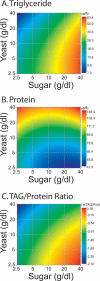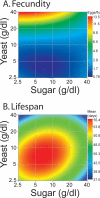Dietary composition specifies consumption, obesity, and lifespan in Drosophila melanogaster - PubMed (original) (raw)
Dietary composition specifies consumption, obesity, and lifespan in Drosophila melanogaster
Danielle A Skorupa et al. Aging Cell. 2008 Aug.
Abstract
The inability to properly balance energy intake and expenditure with nutrient supply forms the basis for some of today's most pressing health issues, including diabetes and obesity. Mechanisms of nutrient homeostasis may also lie at the root of dietary restriction, a manipulation whereby reduced nutrient availability extends lifespan and ameliorates age-related deteriorations in many species. The traditional belief that the most important aspect of the diet is its energetic (i.e. caloric) content is currently under scrutiny. Hypotheses that focus on diet composition and highlight more subtle characteristics are beginning to emerge. Using Drosophila melanogaster, we asked whether diet composition alone, independent of its caloric content, was sufficient to impact behavior, physiology, and lifespan. We found that providing flies with a yeast-rich diet produced lean, reproductively competent animals with reduced feeding rates. Excess dietary sugar, on the other hand, promoted obesity, which was magnified during aging. Addition of dietary yeast often limited or reversed the phenotypic changes associated with increased dietary sugar and vice versa, and dietary imbalance was associated with reduced lifespan. Our data reveal that diet composition, alone and in combination with overall caloric intake, modulates lifespan, consumption, and fat deposition in flies, and they provide a useful foundation for dissecting the underlying genetic mechanisms that link specific nutrients with important aspects of general health and longevity.
Figures
Figure 1. Diet Response Surfaces for metabolic phenotypes
Levels (μg) of triglyceride (A) and protein (B) were measured per fly in each of 25 different diet regimes ranging from 2.5g·dl−1 to 40g·dl−1 sugar and yeast. For each diet, multiple replicates from each diet were used to estimate Diet Response Surfaces (see Experimental Procedures), which robustly characterize the impact of each dietary component on the phenotypes. A summary measure of body composition, which is based on the relative ratio of TAG to total protein is also examined (C). Dietary sugar promotes TAG storage, while dietary protein suppresses it. Actual mean values for each diet and appropriate statistical analyses are presented in the supplementary data (Tables S1 and S2). Female flies of the yw strain are represented here, but similar trends were observed in in males (Figure S1) and in females of the Canton-S (Figure S2) and w1118 (Figure S3) strains.
Figure 2. Diet Response Surfaces for reproductive and longevity phenotypes
Fecundity (A) and lifespan (B) were measured in female flies maintained on each of 25 different diet regimes ranging from 2.5g·dl−1to 40g·dl−1 sugar and yeast. The data were used to estimate Diet Response Surfaces (see Experimental Procedures), which robustly characterize the impact of each dietary component on the phenotypes. Actual mean values for each diet and appropriate statistical analyses are presented in the supplementary data (Tables S1 and S2). Higher levels of dietary protein promote reproduction, while flies have the longest lifespan on a balanced diet. Fecundity is expressed as the eggs/day for each fly averaged over the two weeks (aged 3−17 days).
Figure 3. Drosophila obesity and lifespan are strongly affected by diet composition
(A) Food intake was measured in female flies maintained on each of 25 different diet regimes ranging from 2.5g·dl−1to 40g·dl−1 sugar and yeast. (B) Total caloric intake was estimated based on feeding rate and the nutritional parameters of each diet. The data were used to estimate a Diet Response Surface for total caloric intake. (C and D) For flies maintained on each of the 25 diets, average triglyceride levels (C) and lifespan (D) were rank ordered from smallest to largest values. In the bottom panels the caloric intake on each diet was plotted as a stacked bar chart in terms of calories from sugar (top portion of each bar) and calories from yeast (bottom portion of each bar). In the upper panels, the dietary imbalance was plotted for the same rank order. Dietary imbalance was measured as abs(ln(sugar calories/yeast calories)). It ranges from 0 (balanced diet) to near 3 (severely imbalanced sugar- or yeast-rich diet). Sugar calories and yeast calories promoted obesity and leanness, respectively, while a balanced diet promoted longer life.
Figure 4. Diet composition influences aging-related obesity in Drosophila
Female flies were aged on nine different diets and sampled at 4 ages to assess changes in levels of triglyceride (TAG), the primary lipid storage molecule in Drosophila. Each point represents a single TAG measure obtained from 5 females. Corresponding box plots represent the mean (square symbol), 99% confidence intervals on the mean (box), and range (whiskers) of the data. Therefore, boxes that do not overlap are statistically significantly different at the 1% level. Diets that promoted triglyceride storage early in life (age 13 days) induced dramatic age-dependent increases and resulted in a strong middle-age obesity phenotype.
Figure 5. Dietary components may influence life strategies through their energetic and signaling characteristics
We propose a working model whereby the total energy available to an animal may be diverted towards reproduction, somatic maintenance and/or storage processes. Each of these three energy decisions interacts and harbors an inherent physiological impact on the organism that determines lifespan. Although both yeast and sugar consumption increase the total resources available, cues from high yeast diets drive reproduction and suppress mechanisms of somatic maintenance while cues from high sugar diets preferentially drive energy storage. (A) In a low-yeast/high-sugar environment resources are strongly diverted towards energy storage, resulting in obesity and reduced longevity. (B) In a high-yeast/low-sugar environment, reproduction is simultaneously stimulated (high protein) and de-repressed (low sugar), resulting in very high levels of reproduction that leave few resources for somatic maintenance. (C) Lifespan is optimized on a balanced diet as the interaction between cues from each dietary component maintain energy balance allowing sufficient resources for reproduction, energy storage, and somatic maintenance.
Similar articles
- Water- and nutrient-dependent effects of dietary restriction on Drosophila lifespan.
Ja WW, Carvalho GB, Zid BM, Mak EM, Brummel T, Benzer S. Ja WW, et al. Proc Natl Acad Sci U S A. 2009 Nov 3;106(44):18633-7. doi: 10.1073/pnas.0908016106. Epub 2009 Oct 19. Proc Natl Acad Sci U S A. 2009. PMID: 19841272 Free PMC article. - Protein:carbohydrate ratios explain life span patterns found in Queensland fruit fly on diets varying in yeast:sugar ratios.
Fanson BG, Taylor PW. Fanson BG, et al. Age (Dordr). 2012 Dec;34(6):1361-8. doi: 10.1007/s11357-011-9308-3. Epub 2011 Sep 9. Age (Dordr). 2012. PMID: 21904823 Free PMC article. - High carbohydrate-low protein consumption maximizes Drosophila lifespan.
Bruce KD, Hoxha S, Carvalho GB, Yamada R, Wang HD, Karayan P, He S, Brummel T, Kapahi P, Ja WW. Bruce KD, et al. Exp Gerontol. 2013 Oct;48(10):1129-35. doi: 10.1016/j.exger.2013.02.003. Epub 2013 Feb 10. Exp Gerontol. 2013. PMID: 23403040 Free PMC article. - Dietary restriction in Drosophila.
Partridge L, Piper MD, Mair W. Partridge L, et al. Mech Ageing Dev. 2005 Sep;126(9):938-50. doi: 10.1016/j.mad.2005.03.023. Mech Ageing Dev. 2005. PMID: 15935441 Review. - Obesity and Aging in the Drosophila Model.
Gáliková M, Klepsatel P. Gáliková M, et al. Int J Mol Sci. 2018 Jun 27;19(7):1896. doi: 10.3390/ijms19071896. Int J Mol Sci. 2018. PMID: 29954158 Free PMC article. Review.
Cited by
- Late-life shift in caloric intake affects fly metabolism and longevity.
Li M, Macro J, Meadows K, Mishra D, Martin D, Olson S, Huggins BJ, Graveley BR, Li JYH, Rogina B. Li M, et al. Proc Natl Acad Sci U S A. 2023 Dec 12;120(50):e2311019120. doi: 10.1073/pnas.2311019120. Epub 2023 Dec 8. Proc Natl Acad Sci U S A. 2023. PMID: 38064506 Free PMC article. - Dietary glucose regulates yeast consumption in adult Drosophila males.
Lebreton S, Witzgall P, Olsson M, Becher PG. Lebreton S, et al. Front Physiol. 2014 Dec 22;5:504. doi: 10.3389/fphys.2014.00504. eCollection 2014. Front Physiol. 2014. PMID: 25566097 Free PMC article. - A gut-derived hormone suppresses sugar appetite and regulates food choice in Drosophila.
Malita A, Kubrak O, Koyama T, Ahrentløv N, Texada MJ, Nagy S, Halberg KV, Rewitz K. Malita A, et al. Nat Metab. 2022 Nov;4(11):1532-1550. doi: 10.1038/s42255-022-00672-z. Epub 2022 Nov 7. Nat Metab. 2022. PMID: 36344765 Free PMC article. - Serotonin signaling mediates protein valuation and aging.
Ro J, Pak G, Malec PA, Lyu Y, Allison DB, Kennedy RT, Pletcher SD. Ro J, et al. Elife. 2016 Aug 23;5:e16843. doi: 10.7554/eLife.16843. Elife. 2016. PMID: 27572262 Free PMC article. - Genetic Manipulation of Glycogen Allocation Affects Replicative Lifespan in E. coli.
Boehm A, Arnoldini M, Bergmiller T, Röösli T, Bigosch C, Ackermann M. Boehm A, et al. PLoS Genet. 2016 Apr 19;12(4):e1005974. doi: 10.1371/journal.pgen.1005974. eCollection 2016 Apr. PLoS Genet. 2016. PMID: 27093302 Free PMC article.
References
- Arrese EL, Patel RT, Soulages JL. The main triglyceride-lipase from the insect fat body is an active phospholipase A(1): identification and characterization. J Lipid Res. 2006;47:2656–2667. - PubMed
- Braeckman BP, Houthoofd K, Vanfleteren JR. Insulin-Like Signaling, Metabolism, Stress Resistance and Aging in Caenorhabditis Elegans. Mechanisms of Ageing and Development. 2001;122:673–693. - PubMed
- Bross TG, Rogina B, Helfand SL. Behavioral, physical, and demographic changes in Drosophila populations through dietary restriction. Aging Cell. 2005;4:309–317. - PubMed
- Chumlea WC, Guo SS, Kuczmarski RJ, Flegal KM, Johnson CL, Heymsfield SB, Lukaski HC, Friedl K, Hubbard VS. Body composition estimates from NHANES III bioelectrical impedance data. Int J Obes Relat Metab Disord. 2002;26:1596–1609. - PubMed
- Edgecomb RS, Harth CE, Schneiderman AM. Regulation of feeding behavior in adult Drosophila melanogaster varies with feeding regime and nutritional state. J Exp Biol. 1994;197:215–235. - PubMed
Publication types
MeSH terms
Substances
Grants and funding
- R01AG023166/AG/NIA NIH HHS/United States
- R5T32AG000183-15/AG/NIA NIH HHS/United States
- T32 AG000183/AG/NIA NIH HHS/United States
- R01 AG023166-04/AG/NIA NIH HHS/United States
- R01 AG023166-03/AG/NIA NIH HHS/United States
- R01 AG023166-02/AG/NIA NIH HHS/United States
- R01 AG023166/AG/NIA NIH HHS/United States
LinkOut - more resources
Full Text Sources
Medical
Molecular Biology Databases




